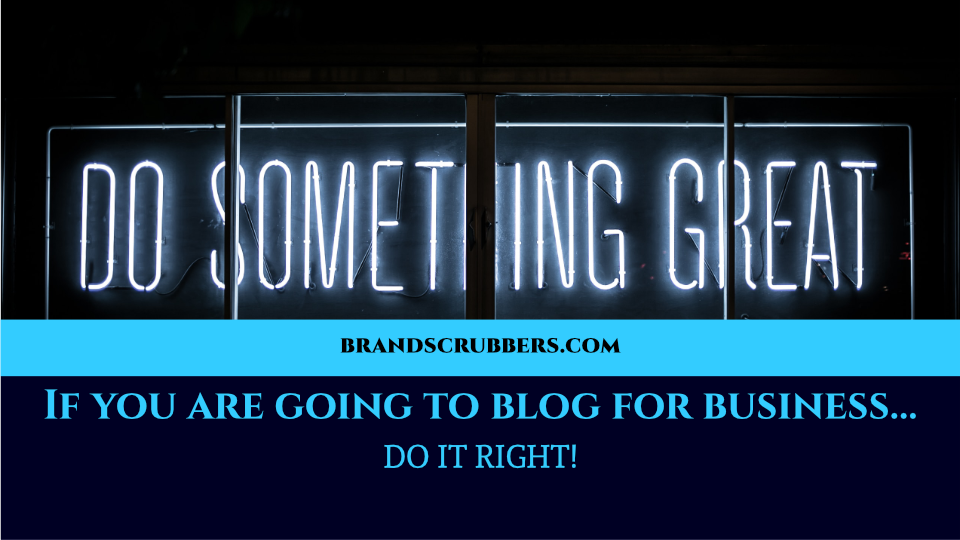Entrepreneurs are often asking me; “Why isn’t my blog bringing in traffic?”. They express that they write, they share, but it doesn’t seem to be making much of an impact.
The first thing I asked them, “Are you doing it right?”
Many can’t answer my question, so it got me to thinking. How can I help other entrepreneurs better utilize their blogs?
By giving them a step by step, repeatable process to take the hard work out of it.
Now, of course, I offer blog writing services, so you are always welcome to reach out. That being said, if you’re a do-it-yourselfer, or simply don’t have the income, this post will help you.
Why blog for business?
We all hear it time and time again – blogging boosts business. This is not wrong, it really does. However, like anything else, you have to do it correctly if you want to maximize your results.
Don’t believe me, here’s a post I wrote about how blogging boosts business. Pay careful attention to the section about website traffic. That’s what I’m going to really hammer into.
Blogging provides an inexpensive means to get your name, brand, and website out there. The extra bonus to blogging is the built-in SEO. Every time you write a blog post it’s one more indexed page and one more opportunity to show up in a search engine.
What you need to understand is that, in order for the SEO to be effective, you have to make sure you’re doing it RIGHT.
SEO? What?
SEO, search engine optimization, isn’t as hard a concept to understand as it may feel like.
Search engine optimization is the technique of utilizing tools and methods. Methods you use to make your site top ranking in the results of search engines. Proper use of SEO and keywords will generate public awareness of your site’s existence. Subsequently, you will generate more traffic. That traffic could lead to potential sales! Which means generating an income for your business.
For the sake of this article, what you need to know is this. Every keyword used appropriately is one more lure in the water. One more chance to catch your fish.
I really broke it down in this post about SEO. Give it a read if the concept still feels shaky for you.

How do I blog right?
To make this as easy to digest as I can, I’m going to break it down into 5 key points:
- Keyword
- Headlines
- Readability
- Links
- Images
If you can nail these, you’ll be on your way in no time. Let’s dive in.
Keyword
When you log onto Google.com and type something into the search bar, do you know what that is? Keywords. Keywords are the terms and phrases your intended audience will use to look things up.
Each keyword is an additional chance to rank on a search, under a different topic. It’s for this reason that you want to aim to have a variety of relevant of keywords. Each blog should focus on 1 keyword that’s relevant to the audience you want to attract.
Steps for choosing a keyword:
- Pick a keyword
- Research it’s reach/appeal ( https://moz.com/explorer )
- Check that you haven’t used it before
That’s the bare minimum right there folks. You don’t need to make it any harder at this stage.
Headlines
Once you have your keyword, you need to write a headline that incorporates it. Don’t forget it also needs to draw in an audience.
A good headline, where SEO is concerned, is neither too long or too short. It’s impactful and engaging. Considering there are so many things out there designed to grab attention, you have to try to do it too.
Doesn’t come naturally to you? That’s alright, check out my favorite tool: Coschedule’s Headline Analyzer
Free and packed full of great headline feedback. It also links to several posts explaining how each part fits together. If you are a beginner, this is the perfect place to start.
Readability
Have you ever read something that was way beyond your reading comprehension? If you have, you know that it’s extremely frustrating. If you have to put your time and effort into deciphering what you are reading that’s even worse. You’re less likely to take action Heck, you’re less likely to finish reading the content.
Knowing that there are a wide range of readers and comprehension levels you adapt how you write. You should always write to the lowest possible shared level. Keep it simple, succinct, and try to leave your thesaurus at home.
You need to aim for a Grade 4 – 6 reading comprehension. Take your information and run it through this free online app, Hemingway. It’s designed to help you write for your audience. Take advantage of it.
If you want to get fancy, you should aim to please those happy little SEO crawlers. These crawlers prefer it if you have a blog post that’s over 300 words total AND no more than 300 words per heading. You want to make the crawlers happy, don’t you?
Links
Web links are like your website’s friends list on Facebook. The more you have, the more popular others think you are. It’s also how crawlers learn to navigate your site. The more things that connect, the easier it is. Like the spider to the fly.
There are 2 types of link an entrepreneur should be concerned with.
- Internal
- Internal links are those that connect to other places on your own website. Crawler heaven baby.
- External
- Links to other sites, it’s especially powerful if the other site links back to you.
Getting other websites to point to yours tells search engines like that you are popular. That you have friends and people like your stuff. It’s clear why you want to obtain them over time.
Where blogs are concerned, try to make sure you link to somewhere else on your own site to give those crawlers some help. Usually, I just make sure to link to another blog I wrote somewhere. Easy as that.
Images
Images are another way that crawlers help to index your site. It’s not by what they look like, but rather how you label them. You can do this by using Alt Text.
MOZ.com has a good piece about this, which you can find here.
Adding alt text to photos serves 3 purposes. For one there are programs to assist visually impaired users that can read alt tags. Alt tags are displayed when your image doesn’t load. It also helps search engine crawlers index the image appropriately.
As I have said before, keep it simple. Make sure you have a blog header image loaded as the feature. Remember to set a descriptive alt title inclusive of the keyword.
It doesn’t have to be fancy. My alt text for the main image in this blog is “blog-business-do-it-right-title”.
Sum it up already!
I’ve done my best to KISS this for you.
(Urgh… stands for Keep It Simple Stupid, I swear I was not trying to kiss you…)
Break it down into steps, and repeat them every time. If you get stuck, let me know, I’ll provide free coaching on this to get you started.
Blogging can do so much for your business so stop putting it off. Save this blog, share it with a friend, and get your tail feathers in gear. You’ve got this.



Recent Comments